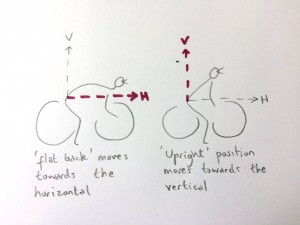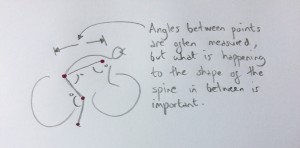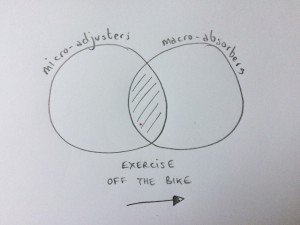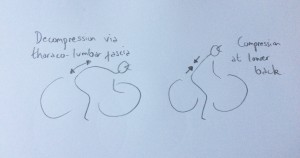The ‘flat back’ position sought after by cyclists has excited the interest of many commentators, fans and onlookers, and by most accounts has been the mark of a good rider. The beginner will give themselves away by their higher handlebar position and more upright upper body, while proper riders ‘slam’ their stem with a more notable ‘drop’ from saddle to bars, achieving a more aggressive, ‘racier’ position and a ‘flatter’ back. The flat back is to bike posture what souplesse is to the pedalling action; It is a sign of class. And while we all understand what the ‘flat back’ refers to in normal cycling parlance, the bio-mechanical factors that underpin it are not so easy to grasp. Aerodynamics plays a big part in the racing cyclists’ preference for a lower front end, but enhanced power output resulting from a lower cock pit and a more forward-tilted pelvis are important elements too.
In contrast to this racy style of position, there is an emerging group of riders who are now sold on the benefits of a more upright bike fit; riders with sensitive lower backs who actively seeking out ‘endurance’ frames with longer head tubes to protect them from injury, and to allow them the comfort to ride for longer and without pain. For the most part these two positions seem polarised, suggesting that a flatter back and a more aggressive position favours speed, power and improved aerodynamics, while an upright riding style is one of comfort and safety.
But is it really true that a straighter, more upright back is a safer position for cyclists with lower back problems? And aside from improved aerodynamics what is it about a flat back that makes it so effective and desirable?
One first important point to raise before discussing this further is that the flat back posture is a misnomer, so in this blog I’m going to discuss in terms of functional biomechanics the cyclists back shape and the factors influencing it. The desirable ‘flat back’ that we talk about amongst ourselves is actually a flexed back, bending forwards from a riders pelvis seated in the saddle to the handlebars. And it is the smoothness and height of this forward bending curve that facilitates the trade mark ‘flat back’ as we might describe it - a low curve that is more towards the horizontal than the vertical - a curve that allows the rider to drive hard with the legs but stay still and low at the front.

From my point of view, range of motion assessments for the spine and key muscles attaching to the pelvis form part of my arsenal in understanding a rider’s position and looking to improve it. There are the obvious things on the bike that can be changed, notably the contact points at the pedals, the saddle and the handlebars. But the factors that impact most on the scope and range of these adjustments are the bodily limiters that are going on in between. Of course things like height and limb length cannot be changed, but for many riders flexibility and mobility can, by consistent targeted stretching of stiff and tight areas, and by acclimatising to the cycling position by way of progressive time spent in the saddle.
Having been involved in a bike fitting service with Mal Pires at le beau velo from from 2012 -2016, and now offering a bio-mechanically minded bike fit of my own, I’ve have been lucky enough to measure, assess and analyse the issues across hundreds of bodies, with fittings for both bespoke and ‘off the peg’ examples too. On many occasions a rider coming in for a bike fit has already had several opinions and is looking for the holy grail, the solution that will make them faster, more comfortable, and sometimes pain free. Often you can guess where a client has had their previous fit by the set up of their machine, as each ‘school’ seems to come with its own philosophy. Some are known for their unusual frame geometry outside the standard off the peg possibilities, catering for the customer needing rehab/pre-hab, or ‘comfort’ when working around a known problem area. Often riders with back or neck problems have favoured a high and short front end and a longer than usual head tube, or lots of spacers. Others clearly favour power and performance, and go for the highest possible saddle set up, often with a slightly forwards position and a lower front end.
In bio-mechanical terms, it has become increasingly apparent to me that the body elements (flexibility in particular) impact significantly on the possible back shape any rider can achieve between the contact points of the seat and handlebars. Whilst many bike fits quantifiably measure limb angles and the relationship and alignment between body measures (such as the angle of the line from hip to shoulder), often it is simply the discerning eye of an experienced bike fitter who must observe the shape of the back in between, and makes a judgement on the position accordingly. Visually, the shape of the back of a rider in a well-balanced position should have close to the pleasing ‘flat back’, with a smooth flexed curve and no obvious crunch points or hinges. In spite of all the technology and algorithms offered by many modern fits, understanding what makes a good back shape and helping a rider achieve it can be key to finalising a working position.

Some riders have the capacity to explore all the options, and push the envelope at the performance end to see what they can tolerate. Others are very restricted in what they can achieve, resisting even small changes because it upsets the balance of their body and how it feels on the bike. Most obvious to any keen-eyed observer is that some people just look good on a bike, while others do not, and for the most part this is connected to the rider’s ability to mould their body to any bike and still make it work for them efficiently. In his book ‘Bikefit’, Phil Burt refers to these riders as ‘Macro absorbers’, whilst those riders who feel every minor change in their set up he calls ‘micro-adjusters’. The experiences he retells in his book reflect that even in the professional peloton both kinds of rider exist.
In my view, robust riders who are in good physical shape, with flexibility in their spine and hips, and a level of efficiency developed through hours in the saddle can drop into an effective and attractive position relatively easily. More sensitive riders with perhaps chronic tight areas, an injury history or an ongoing issue may have their own personal biomechanical limiters which amplify the need for fine tuning the contact points (saddle, pedals and bars). In the general population it is often the sensitive micro-adjusters who are looking for answers and solutions from multiple bike fits. From my point of view as an exercise professional, changing the bike will only get you so far with a micro-adjuster. Changing the body, though it may take more time and effort, will extend the potential positions that can be made possible further.

Key factors for me to take into account are range of motion of the spine, and the length-tension relationships of the muscles around the pelvis (the hamstrings, gluteals and hip flexors in particular). Measuring these elements off the bike first, and then finding a way to assess their impact on the bike second, has been key to developing my understanding of finding and developing a comfortable and powerful bio-mechanical position for any rider.
In particular, a measure of pelvic tilt (as measured from anterior superior iliac spine to posterior superior iliac spine), and its relationship with knee extension (reach to the pedal) has become an important element of my bike fit. I have written previous blogs about these individual elements as I began to understand them back in 2012. You can retrace them here:
http://jomcrae.co.uk/bike-fit-part-1/
http://jomcrae.co.uk/bike-fit-blog-part-deux/
The pelvis is of course the power centre for any cyclist, which is why saddle height is usually adjusted first. But the delicate balance between the driving muscles at the pelvis and the muscles pulling on the cockpit at the front needs to be negotiated to provide optimal handling and control of the bike as well as power production. The shape of the cyclists back is not only determined by the tension and pull of any muscles acting at either end of any given position, but also the resistance in the spine itself to stretch and move into an elongated shape. Segmental mobility of the spine is particularly important, meaning that each vertebra must be mobile enough to move and respond to the stretch being placed on it in the cycling position. Where the bones of the spine are stiff or ‘fixed’ through any area, it will resist the flat back position and show as an excessively hunched area unable to respond and change even as a position is adjusted around it. This should not be confused with a poor position which can create this shape because the spine is not being stretched adequately by the set up.
While there are aerodynamic advantages to being lower at the front (reducing frontal area), and biomechanical advantages too (greater anterior pelvic tilt – the rolling forward on the saddle that allows for the powerful gluteal muscles to get more involved), there is an important tension that must be created throughout the whole body that is perhaps sometimes overlooked, and avoided by riders with lower back problems in particular.
Adequate drop and reach tensions the connective tissues that connect the moving muscles of the legs and hips, with the skeletal structure of the spine, and the stabilising muscles of the upper body. Often, we think of tension as a negative thing, but if you imagine this tension as tethering, you have a better idea of how the curve of the spine in a good position works in practice, being stretched and tethered at both ends through the connective tissue that links them – the thoracolumbar fascia. Wikipedia won’t help you much in understanding the anatomy of this complex layered tissue (I’ve checked), so I’ll do my best here to help explain its importance here.
First let me recap my definition of fascia from my book “Ride Strong – Essential Conditioning for cyclists”:
"‘Fascia’ is the term given to a band of connective tissue that attaches, stabilises, encloses and connects muscles or organs of the body. Collectively these fascial layers form a complex layered web of tissue throughout the whole body. Maintaining the pliability of these tissues is as important as maintaining muscle length.”
As the name suggests the thoracolumbar fascia links the thorax (chest or upper body) with the lumbar region (the lower back and pelvis), and with three layers as well as fibres criss-crossing right to left (and vice versa), the layers act as an important and dynamic bridge between the upper and lower body. The thoracolumbar fascia is intimately linked with ‘core’ muscles you may have heard of as a cyclist, such as the hip flexors, the quadratus lumborum, and the erector spinae, and is indirectly linked to the muscles of the hips and legs via attachments at the pelvis. Moreover, layers and fibres of this tissue connect directly to the vertebrae of the spine, impacting on the tension created at each segment throughout.
The thoracolumbar fascia comes into its own in any forwards bending movement, when (with a functioning core) it works to decompress the lumbar spine and separate each vertebrae. This is particularly important in off-loading the lumbar discs when the spine is flexed under with light to moderate loads (I talk more about the importance of learning to lift heavier loads with a ‘neutral spine’ in my book, but that’s not what we’re talking about here).
Now consider this anatomy in light of the cyclists position bent forward seated on their bike, leg and hip muscles stretching and working as they reach with every pedal stroke, and arms reaching to steady the upper body at the handlebars. Ideally a balanced stretch coming from both ends of the position has a tethering effect at the lower back via the thoracolumbar fascia, making it feel more comfortable and allowing all the relevant muscles to work optimally. As a rider works harder, pushing more with the legs and pulling on the handlebars more tightly, the core becomes more active and this clever mechanism dissipates this force at the lower back by separating each lumbar segment, taking the strain off important structures like the lumbar discs and connecting the upper and lower body to transmit maximum power to the ground through the bike.
 In a bike position where a rider sits with a more upright spine, with less weight held through the handlebars and more load centred around the lower back, this mechanism is somewhat impaired. As compared to the well-balanced bike position described above, a more upright back is less ‘active’ in the core, and represents a passive sitting position that can often lead to the sensation of ‘crunching’ or compression through the lower back.
In a bike position where a rider sits with a more upright spine, with less weight held through the handlebars and more load centred around the lower back, this mechanism is somewhat impaired. As compared to the well-balanced bike position described above, a more upright back is less ‘active’ in the core, and represents a passive sitting position that can often lead to the sensation of ‘crunching’ or compression through the lower back.
Consider an ordinary cyclist with a typically stiff lower back, with poor posture and lumbar discs that are migrating steadily backwards. A position with a slight forward bend without a lot of weight or work through the arms is likely to be much more provocative than one where a balanced tension is created from the front to the back allowing the thoracolumbar fascia to do its job. The tensioning needs to be balanced between all three contact points to achieve the desired result, but having adequate drop and reach at the bars relative to a sensible saddle height is key to bio-mechanical and literal balance.
Naturally the extent of the drop and reach will depend on the riders height and limb proportions as well as their flexibility, any issues and goal events. However, I’ve come across many riders who have very little drop at all, or even a negative drop (the handlebars are higher than the saddle) which in my view negates some of the fundamental points of a drop handlebar road bike.* The interplay between drop and stem length or top tube length can make an important difference too, and some riders who can’t manage very much drop, may do well by lengthening further instead.
[The only exception I’ve come across where a handlebar higher than saddle position is more appropriate long-term is where arthritic changes in the neck become prohibitive, in which instance a more hybrid type set up could be recommended].
I have found that even for cyclists diagnosed with a disc bulge a properly balanced cycling position (with a moderate amount of drop and reach) is often less provocative that sitting for long periods in a chair. A well-adjusted cycling position is at least a dynamic flexed position, stretching the lumbar spine via the thoracolumbar fascia and opening up the posterior space where the discs might need room. Sitting in a chair for hours on end is much more problematic, compressing the lumbar discs and aggravating symptoms.
Naturally the amount and intensity of any riding for anyone with back pain needs to be carefully considered together with taking steps to change the underlying elements that caused the problem in the first place. But shooting for an upright position and a higher, shorter front end is not the solution. Most important for any rider with a sensitive back is their appreciation of the issues involved and a need for a patient process led approach to a bike fit, as well as a commitment to change the body through appropriate exercise.
Equally important for beginner to intermediate cyclists is an understanding that a full ‘racing’ position from the get-go might provoke problems and prevent the steady progression that makes for consistent training. There is no hard and fast right or wrong to a bike fit, but I believe the trend towards higher, shorter front ends (both for beginners and those with back problems) is often a mistake. Having said that, I also believe that a progressive move towards your optimal set up will be enhanced by off the bike exercise to increase the range of movement in restrictive areas. The body is dynamic, and so your bike fit should be too.
